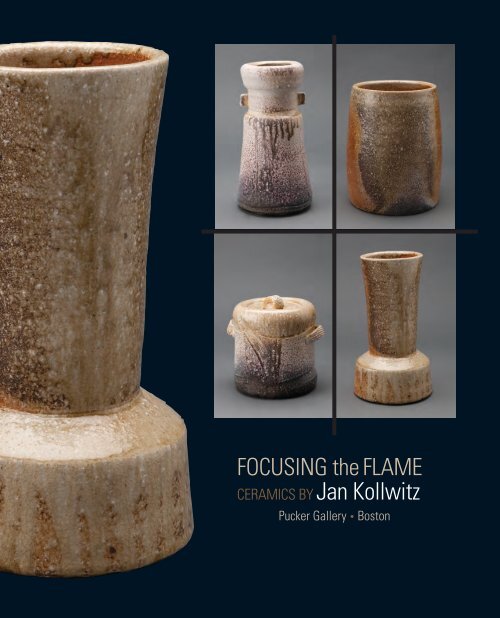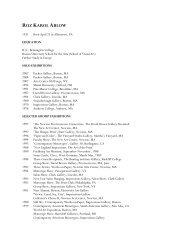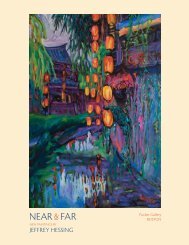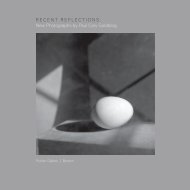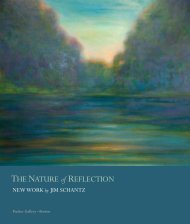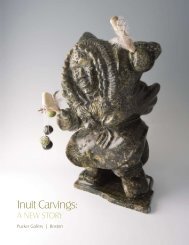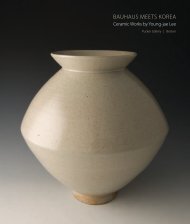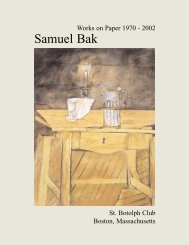You also want an ePaper? Increase the reach of your titles
YUMPU automatically turns print PDFs into web optimized ePapers that Google loves.
FocusinG the Flame<br />
ceramics By Jan Kollwitz<br />
<strong>Pucker</strong> <strong>Gallery</strong> • Boston
Kabin<br />
(Square vase)<br />
6 ¼ x 4 ¾ x 4 ¾"<br />
KJ19<br />
On the COver ClOCKwIse frOM tOp left:<br />
Iga hanaire<br />
(Flower vase for tea ceremony in Iga style)<br />
12 x 6 ½ x 6 ½"<br />
KJ39<br />
Kyozutsu<br />
(Sutra scroll container)<br />
11 ¼ x 8 ¼ x 7 ¾"<br />
KJ33<br />
All wOrKs Are stOnewAre wIth nAturAl Ash glAze.<br />
Kinuta hanaire<br />
(Fulling block-shaped vase)<br />
11 ¼ x 6 ¼ x 6 ¼"<br />
KJ28<br />
Mizusashi<br />
(Water container)<br />
8 x 8 x 7"<br />
KJ7
FocusinG the Flame<br />
ceramics By Jan Kollwitz<br />
In ancient Japan, glazing was not considered an essential<br />
aspect of ceramics production. potters found that<br />
they could create serviceable high-fired stoneware vessels<br />
simply by firing the unglazed clay for up to a week<br />
at temperatures of 1,200 degrees centigrade or higher.<br />
the kilns these potters used were tunnels dug into the<br />
sides of hills, with a flue opened further up the slope.<br />
these tunnel kilns, or anagama, were relatively inefficient,<br />
consuming vast amounts of wood and requiring days of<br />
firing to completely fuse the clay body. Inevitably, debris from<br />
the kiln roof fell onto some of the pieces, while others slumped<br />
from being too close to the fire mouth at the entrance or fired<br />
incompletely from being too far away. estimates of loss in<br />
each firing run as high as fifty percent, or even higher.<br />
Yet, the pieces created by this inefficient, time-consuming<br />
process, although intended for use as simple, utilitarian vessels,<br />
have captured the attention of ceramics lovers for centuries.<br />
As early as the late fifteenth century, masters of Japanese<br />
tea practice selected works of native unglazed stoneware for<br />
use in a mode of tea gathering they referred to as “cold and<br />
withered.” this aesthetic approach contrasted with the use<br />
of fine Chinese utensils and artworks, which were expensive<br />
and more lavish in appearance.<br />
following the publication of Bernard leach’s A Potter’s<br />
Book in 1940, Japanese ceramics approaches and aesthetics<br />
became familiar to craftspeople in europe and north America.<br />
from the early 1970s, ever-increasing numbers of potters<br />
from the west traveled to Japan to study with masters of<br />
traditional ceramics lineages. Most of these potters returned<br />
home to establish studios that were based in some way on<br />
Japanese ceramics workshop traditions.<br />
Among the more radical transplanted approaches was the<br />
use of wood-firing kilns. some potters who built such kilns<br />
based their early designs on the “climbing kilns” (noborigama)<br />
introduced to Japan from Korea at the end of the sixteenth<br />
century. Others, however, built a modified form of the<br />
3<br />
older anagama, using a single above-ground firing chamber<br />
of brick to replace the more volatile tunnel constructions used<br />
centuries ago.<br />
the potter Jan Kollwitz is one of those for whom woodfired<br />
stoneware proved to have an irresistible fascination. Yet,<br />
not content to simply reproduce the outward forms, he has<br />
internalized many deep and significant aspects of Japanese<br />
culture. his lifestyle, working environment, and finished pieces<br />
are influenced by Kollwitz’s understanding of such seminal<br />
aspects of traditional Japanese culture such as zen Buddhism<br />
and the tea ceremony (chanoyu).<br />
Born in Berlin, Jan Kollwitz now works in the village of Cismar,<br />
near the Baltic sea. his wood-burning anagama kiln was<br />
built in 1988 by the Japanese master kiln builder watanabe<br />
tatsuo. It has served Kollwitz well for more than two decades.<br />
Over time, Kollwitz has gained the ability to predict with relative<br />
confidence which areas of his kiln will yield the effects<br />
he desires. even so, each firing results in surprises that evoke<br />
pleasure and wonder. the kiln has become a collaborator—<br />
not simply a construction of bricks, but a semi-independent<br />
force that adds its own unique contributions to the outcome<br />
of each piece.<br />
Kollwitz creates ceramics inspired by Japan out of a respect<br />
for the foundations of Japanese culture, not out of a<br />
desire to simply imitate Japanese forms, styles, and methods.<br />
examining his pieces, one is struck by his extreme sympathy<br />
for Japanese sensibilities. Despite the relatively unpredictable<br />
nature of his collaboration with the kiln, Kollwitz’s woodfired<br />
ceramics are exquisite manifestations of what Japanese<br />
connoisseurs themselves value most highly in ceramics.<br />
this attests to not only his careful selection of materials and<br />
construction of forms, but also to his sensitive placement of<br />
pieces in the kiln and his intuitive decisions about which examples<br />
are chosen to enter his oeuvre.<br />
some of Kollwitz’s ceramics are notable for their subtlety;<br />
others are striking for their dramatic contrasts. pieces like KJ4,
KJ7, and KJ12 display black scorching (koge) on the lower<br />
area that is rarely found even on unglazed wood-fired ceramics<br />
in Japan. this manifestation links Kollwitz’s work with<br />
the Japanese ceramic type known as Iga, a bold, yet enigmatic<br />
ware that reached its height of popularity in the early<br />
seventeenth century. Iga shares certain characteristics with<br />
neighboring shigaraki, another ceramic type that Kollwitz<br />
credits with influencing his work, including rough, off-white<br />
clay and typically heavy deposits of incidental glaze.<br />
It is the fall of ash that creates the speckling, sheen,<br />
glazing, or flow that decorates an unglazed wood-fired<br />
piece. wood ash contains minerals such as silica that do<br />
not burn up in the firing, but are blown through the kiln by<br />
the kiln draft, falling randomly according to their weight,<br />
the strength of the kiln draft, the temperature, and any obstructions<br />
that may impede its course. generally, the surfaces<br />
of items that face the source of the kiln draft will receive<br />
a heavier deposit or coating of ash glaze. thus, most<br />
unglazed wood-fired pieces have a clear “front” and “back”<br />
(KJ17, KJ<strong>22</strong>, KJ24).<br />
Other surface effects, such as flashing (hi-iro) are caused<br />
by variations in the kiln atmosphere at certain points in the<br />
firing process as well as the location of a specific piece in<br />
relation to other pieces. Kollwitz has achieved some arresting<br />
contrasts in cool and warm colors as a result of this<br />
manifestation (KJ19).<br />
Kollwitz’s principal teacher in Japan was the echizen<br />
potter nakamura Yutaka. traditional echizen ware is known<br />
for the small jars called ohaguro tsubo (tooth-blackening<br />
jars). Kollwitz has succeeded in recreating these jars in an<br />
eerily accurate manner, to the point that one imagines that<br />
they are just how antique echizen jars must have looked<br />
when they were new (KJ20, KJ21). such an ability to<br />
capture the spirit of wares of five hundred years ago is rare<br />
even among the best Japanese potters.<br />
An apparent anomaly in Kollwitz’s work is his black tea<br />
bowls (K23). these bowls are among his rare ceramics that<br />
feature applied glaze. Yet even these bowls reflect the way<br />
in which firing impacts a work’s appearance. these bowls<br />
are of a variety known as “pulled-out black” (hikidashiguro),<br />
created in the late sixteenth century at the Mino<br />
4<br />
kilns of central Japan. potters in Mino discovered that if<br />
they glazed bowls with a brown iron glaze and pulled them<br />
out in the midst of firing and quenched them in water, the<br />
glaze would turn out not brown, but jet-black. Kollwitz performs<br />
this operation using long tongs to pull a glowing tea<br />
bowl out of the flaming kiln, giving the impression of a serene<br />
form of action art.<br />
not all of Kollwitz’s forms are Japanese in origin. Among<br />
his pieces are pitchers (not a traditional Japanese shape)<br />
and a number of distinctly original jar, vase, and platter<br />
forms. nevertheless, each of his pieces demonstrates his<br />
intense focus on achieving a perfect je ne sais quoi.<br />
the Kollwitz estate and workshop is located in an old<br />
parsonage in Cismar that is a monument of shaker-esque<br />
simplicity and understated elegance. Kollwitz’s workshop<br />
and gallery reflect a successful marriage between the<br />
teutonic utilitarian approach and the austere aesthetics of<br />
a Japanese tea master. stark white walls and varying warm<br />
and cool tones of unpainted wood provide a ready backdrop<br />
for his ceramic shapes. executing all the necessary<br />
processes of ceramic production himself, from digging<br />
and preparing clay to the actual firing, Kollwitz carries on<br />
a lifestyle something like that of a Buddhist monk, and<br />
indeed, zen has had a significant impact on his life.<br />
It is interesting, though not essential, to note that Jan<br />
Kollwitz’s great-grandmother was the important german<br />
printmaker Käthe Kollwitz. In contrast to his greatgrandmother’s<br />
intense artistic focus on social justice and the<br />
masses, Jan Kollwitz performs his work in a more solitary<br />
mode and with a less concrete, or perhaps, less clearly<br />
defined, objective. even so, his ceramic works, like the<br />
poignant prints of his great-grandmother, ably demonstrate<br />
art’s remarkable ability to move the human spirit.<br />
—AnDrew l. MAsKe<br />
Andrew L. Maske specializes in Asian ceramics and ceramics inspired<br />
by Asian traditions. He is Assistant Professor of Art History at the University<br />
of Kentucky in Lexington. Professor Maske received a doctorate<br />
in Japanese Art History from Oxford University. In 2007 he was a<br />
Fulbright Research Fellow in the Beijing University Department of Fine<br />
Arts, where he studied contemporary Chinese art ceramics.
Kake-hanaike<br />
(Hanging flower vase)<br />
7 ½ x 3 x 3"<br />
KJ17<br />
5<br />
Ohaguro tsubo<br />
(Small jar to hold tooth-blackening material)<br />
4 x 4 x 4"<br />
KJ21<br />
Iga hanaire<br />
(Flower vase for tea ceremony in Iga style)<br />
10 ¾ x 5 ½ x 5 ½"<br />
KJ30
Chawan<br />
(Tea bowl)<br />
3 ¾ x 4 ¾ x 4 ¾"<br />
KJ<strong>22</strong><br />
Chawan, hikidashi-guro<br />
(Tea bowl, "pulled-out black" glaze)<br />
3 ½ x 4 ½ x 4 ¼"<br />
KJ23<br />
vessel in Jomon style<br />
11 ¾ x 6 ¼ x 5 ½"<br />
KJ8<br />
6
pitcher<br />
9 ¼ x 8 ½ x 6"<br />
KJ16<br />
Ohaguro tsubo<br />
(Small jar to hold tooth-blackening material)<br />
4 x 4 x 4"<br />
KJ20<br />
7
Yama-jawan<br />
(Rice bowl)<br />
3 ¼ x 6 ¼ x 6 ¼"<br />
KJ65<br />
Iga hanaire<br />
(Flower vase for tea ceremony in Iga style)<br />
7 ½ x 4 ¼ x 4 ¼"<br />
KJ35<br />
8<br />
Yama-jawan<br />
(Rice bowl)<br />
3 ¼ x 6 ¼ x 6 ¼"<br />
KJ64<br />
Iga hanaire<br />
(Flower vase for tea ceremony in Iga style)<br />
7 ½ x 4 ¼ x 4 ¼"<br />
KJ3
Iga hanaire<br />
(Flower vase for tea ceremony in Iga style)<br />
10 ¼ x 5 x 5"<br />
KJ12<br />
9<br />
Kinuta hanaire<br />
(Fulling block-shaped vase)<br />
9 x 5 ¼ x 5 ¼"<br />
KJ11
hanaike<br />
(Vase for flower arrangement in the tea room)<br />
9 x 4 ¾ x 4 ¾"<br />
KJ5<br />
Kinuta hanaire<br />
(Fulling block-shaped vase)<br />
10 x 5 ¾ x 5 ¾"<br />
KJ29<br />
10
Kabin<br />
(Square vase)<br />
5 ½ x 4 x 4"<br />
KJ48<br />
11<br />
Kyozutsu<br />
(Sutra scroll container)<br />
7 ½ x 6 ½ x 6 ½"<br />
KJ46<br />
sara<br />
(Square plate)<br />
1 x 10 x 10 ¼"<br />
KJ54
hanaike<br />
(Vase for flower arrangement in the tea room)<br />
9 x 4 ¾ x 4 ¾"<br />
KJ38<br />
12<br />
Iga hanaire<br />
(Flower vase for tea ceremony in Iga style)<br />
11 x 5 ½ x 5 ½"<br />
KJ31
Oke<br />
(Water-holding vessel for tea ceremony)<br />
8 ¾ x 7 ½ x 7"<br />
KJ32<br />
13<br />
Oke<br />
(Water-holding vessel for tea ceremony)<br />
9 x 7 ½ x 7 ½"<br />
KJ10<br />
Yunomi<br />
(Tea cup)<br />
2 ¾ x 3 ¾ x 3 ¾"<br />
KJ66<br />
Kyozutsu<br />
(Sutra scroll container)<br />
7 ¾ x 6 x 6"<br />
KJ4<br />
Yunomi<br />
(Tea cup)<br />
2 ¾ x 3 ¾ x 3 ¾"<br />
KJ67
tsubo<br />
(Jar)<br />
7 x 6 ½ x 6 ½"<br />
KJ26<br />
Iga hanaire<br />
(Flower vase for tea ceremony in Iga style)<br />
11 ¾ x 6 ½ x 6 ½"<br />
KJ6<br />
14<br />
Chawan<br />
(Tea bowl)<br />
3 ½ x 5 ¾ x 5 ¾"<br />
KJ61
tsubo<br />
(Jar)<br />
10 x 7 ¼ x 7 ¼"<br />
KJ27<br />
15<br />
Iga hanaire<br />
(Flower vase for tea ceremony in Iga style)<br />
8 ¼ x4 ¼ x 4 ¼"<br />
KJ36<br />
sara<br />
(Small bowl)<br />
1 ¼ x 4 ¼ x 4 ¼"<br />
KJ56<br />
sara<br />
(Small bowl)<br />
1 ¼ x 4 ½ x 4 ½"<br />
KJ55<br />
shiho sara<br />
(Rectangular platter)<br />
1 ½ x 10 x 5 ¼"<br />
KJ57
hanaike<br />
(Vase for flower arrangement in the tea room)<br />
7 ½ x 3 x 2 ¾"<br />
KJ50<br />
hanaike<br />
(Vase for flower arrangement in tea room)<br />
8 ¾ x 5 x 5"<br />
KJ37<br />
16
hanaike<br />
(Vase for flower arrangement in the tea room)<br />
7 ½ x 2 ¾ x 2 ¾"<br />
KJ51<br />
Yunomi<br />
(Tea cup)<br />
3 ¾ x 3 ¾ x 3 ¾"<br />
KJ60<br />
Mizusashi<br />
(Water container)<br />
7 ¼ x 7 ½ x 7 ½"<br />
KJ34<br />
17
echizen tsubo<br />
(Jar in Echizen style)<br />
8 ¾ x 7 ½ x 7 ½"<br />
KJ25<br />
Yunomi<br />
(Tea cup)<br />
3 ¼ x 3 ½ x 3 ½"<br />
KJ58<br />
18<br />
Iga hanaire<br />
(Flower vase for tea ceremony in Iga style)<br />
12 x 6 ½ x 5"<br />
KJ14
Iga hanaire<br />
(Flower vase for tea ceremony in Iga style)<br />
11 ½ x 6 x 6"<br />
KJ40<br />
19<br />
Iga hanaire<br />
(Flower vase for tea ceremony in Iga style)<br />
10 ¾ x 5 ½ x 5 ½"<br />
KJ45
Ohaguro tsubo<br />
(Small jar to hold tooth-blackening material)<br />
5 x 4 ¾ x 4 ¾"<br />
KJ62<br />
Ohaguro tsubo<br />
(Small jar to hold tooth-blackening material)<br />
5 x 4 ½ x 4 ½"<br />
KJ63<br />
hanaire<br />
(Flower vase for tea ceremony)<br />
12 x 5 ½ x 5 ½"<br />
KJ44<br />
20
sara<br />
(Large bowl)<br />
2 ¾ x 18 x 18"<br />
KJ42<br />
21
sara<br />
(Large bowl)<br />
2 ¾ x 17 ¾ x 17 ¾"<br />
KJ43<br />
<strong>22</strong><br />
CREdITS:<br />
Design: Leslie Anne Feagley<br />
Editors: destiny M. Barletta and Justine H. Choi<br />
Photography: John davenport, Leslie Anne Feagley and Keith McWilliams<br />
© 2012, <strong>Pucker</strong> <strong>Gallery</strong><br />
Printed in China by Cross Blue Overseas Printing Company
1960 Born in Berlin, Germany<br />
1983–1985 Studied with Horst Kerstan, Kandern, Germany<br />
1986–1987 Studied with Yutaka Nakamura, Echizen, Japan<br />
1987–2012 Exchange with Kazu Yamada, Echizen, Japan<br />
1988 Construction of wood-fired anagama by Tatsuo Watanabe<br />
in Cismar, Germany<br />
1988 Workshop established in Cismar, Germany<br />
1990–2012 Exhibitions in Germany and abroad<br />
2011 Fellowship at Villa Massimo, Rome, Italy<br />
2012 Recipient of the Prefectural Culture Award,<br />
“Kulturpreis Ostholstein”<br />
Public Collections<br />
Schleswig-Holsteinisches Landesmuseum Schloss Gottorf,<br />
Schleswig, Germany<br />
Kunstsammlungen der Veste Coburg, Germany<br />
Käthe-Kollwitz-Museum, Berlin, Germany<br />
Keramik-Museum, Berlin, Germany<br />
Grassi-Museum, Leipzig, Germany<br />
Kreissparkasse Köln, Cologne, Germany<br />
Hällisch-Fränkisches Museum, Schwäbisch Hall, Germany<br />
Keramion Frechen, Germany<br />
Sparkassenstiftung Schleswig-Holstein, Kiel, Germany<br />
Sparkasse Ostholstein, Eutin, Germany<br />
Emslandmuseum Schloss Clemenswerth, Sögel, Germany<br />
Museum für Kunst und Gewerbe, Hamburg, Germany<br />
Peter Siemssen Foundation, Ratzbek, Germany<br />
Museum für Asiatische Kunst, Berlin, Germany<br />
<strong>22</strong><br />
Jan KollWiTZ<br />
Biography<br />
Selected Solo Exhibitions<br />
2012 <strong>Pucker</strong> <strong>Gallery</strong>, Boston, Massachusetts, USA<br />
Museum Eckernförde, Germany<br />
2011 Kunsthandel Klefisch, Cologne, Germany<br />
Praxisstipendium Villa Massimo, Rome, Italy<br />
2010 Käthe Kollwitz Museum, Cologne, Germany<br />
Museum für Ostasiatische Kunst, Berlin, Germany<br />
2009 Künstlermuseum Heikendorf, Germany<br />
2008 Ostholstein-Museum, Eutin, Germany<br />
Museum Kellinghusen, Germany<br />
2007 Käthe Kollwitz Haus, Moritzburg, Germany<br />
Goethe-Institut, Hamburg, Germany<br />
Philipps Art-Forum, Bochum, Germany<br />
Studio Pels-Leusden, Berlin, Germany<br />
2005 Museum Kellinghusen, Germany<br />
Bürgergalerie Neumünster, Germany<br />
Kunstraum - B, Kiel, Germany<br />
Töpfermuseum, duingen, Germany<br />
2003 Studio Pels-Leusden, Berlin, Germany<br />
Rosenthal Studio-Haus Galerie, Hamburg, Germany<br />
2002 Museum im Schloss Bad Pyrmont, Germany<br />
Zen-art Galerie Hennig, Hamburg, Germany<br />
2001 Ostholstein-Museum, Eutin, Germany<br />
EKO-Haus der japanischen Kultur, düsseldorf, Germany<br />
Zen-art, Galerie Hennig, Hamburg, Germany<br />
2000 Landhaus Nösse, Sylt, Germany<br />
1999 Galerie Faita, Hamelin, Germany<br />
Emslandmuseum Schloss Clemenswerth, Sögel, Germany<br />
1998 Galerie Objekta, Kreuzlingen, Switzerland<br />
Rosenthal Studio-Haus-Galerie, Hamburg, Germany<br />
Studio Pels-Leusden, Berlin, Germany<br />
1997 Galerie Rosenhauer, Göttingen, Germany<br />
Galerie beim Roten Turm, Sommerhausen, Germany<br />
Schlossgalerie Weiher, Bayreuth, Germany<br />
1996 Galerie Lommel, Leverkusen, Germany<br />
Loes & Reinier, deventer, Netherlands<br />
1995 Zen-Galerie, Hamburg, Germany<br />
1994 Galerie Charlotte Hennig, darmstadt, Germany<br />
Keramikmuseum der Stadt Frechen, Germany<br />
1993 Schleswig-Holsteinisches Landesmuseum, Germany<br />
Kloster Cismar, Germany<br />
1992 Lauenburgischer Kunstverein, Büchen, Germany<br />
1991 Galerie Theis, Berlin, Germany
puCKer gAllerY<br />
171 Newbury Street<br />
Boston, MA 02116<br />
Phone: 617.267.9473<br />
Fax: 617.424.9759<br />
E-mail: contactus@puckergallery.com<br />
To view this catalogue and other <strong>Gallery</strong> publications<br />
and to experience an audio tour of the exhibition,<br />
please visit www.puckergallery.com.<br />
gAllerY hOurs:<br />
Monday through Saturday 10:00 am to 5:30 pm<br />
Sunday 10:30 am to 5:00 pm<br />
We offer one free hour of validated parking at the<br />
200 Newbury Street Garage. The garage driving<br />
entrance is located on Exeter Street between<br />
Newbury and Boylston Streets. The nearest<br />
MBTA stop is Copley Station on the Green Line.<br />
<strong>Pucker</strong> <strong>Gallery</strong> is a member of the Boston Art dealers’<br />
Association and the New England Appraisers Association.<br />
Change Services Requested.<br />
echizen otsubo<br />
(Large jar in Echizen style)<br />
28 ½ x 28 x 28"<br />
KJ24<br />
FocusinG the Flame<br />
ceramics By Jan Kollwitz<br />
DaTes:<br />
5 – 28 may 2012<br />
oPeninG recePTion:<br />
5 may 2012<br />
3:00 to 6:00 pm<br />
The public is invited to attend.<br />
The artist will be present.


